
 |
|
|
#1 |
|
Member
Join Date: Jun 2008
Posts: 119
|
anyone here collect these?
to me they always remind me of overgrown ornate silverware. |
|
|

|
|
|
#2 |
|
Vikingsword Staff
Join Date: Nov 2004
Posts: 6,378
|
|
|
|

|
|
|
#3 |
|
Member
Join Date: Dec 2004
Location: Inland Empire, Southern California USA
Posts: 160
|
Here is my Gaucho knife. Not sure of age, but it is sure pretty. I like.
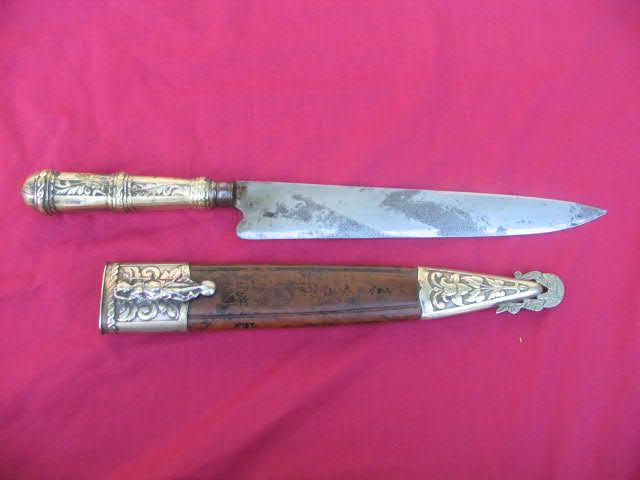 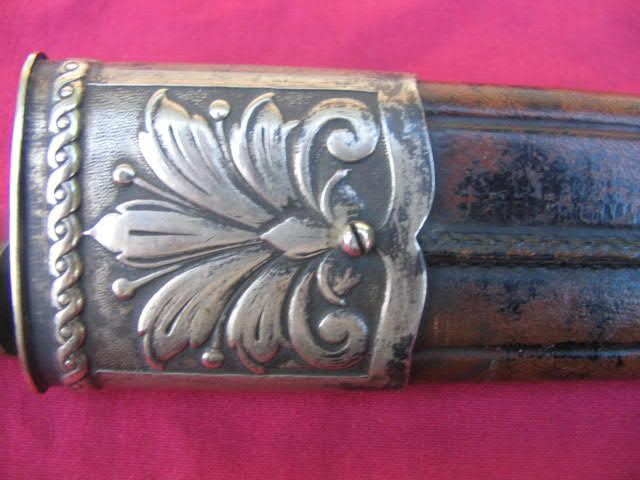 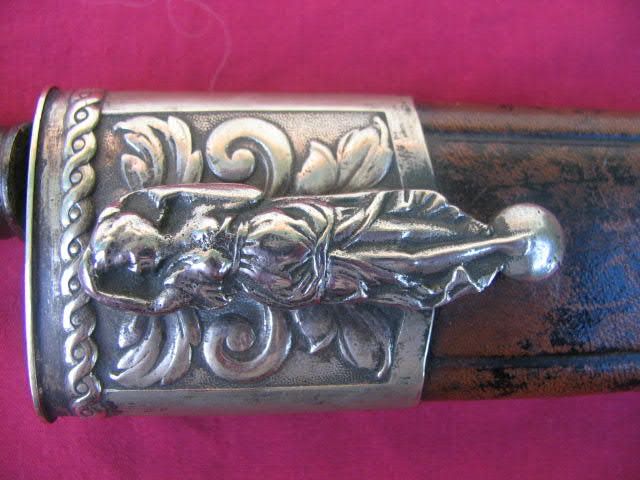 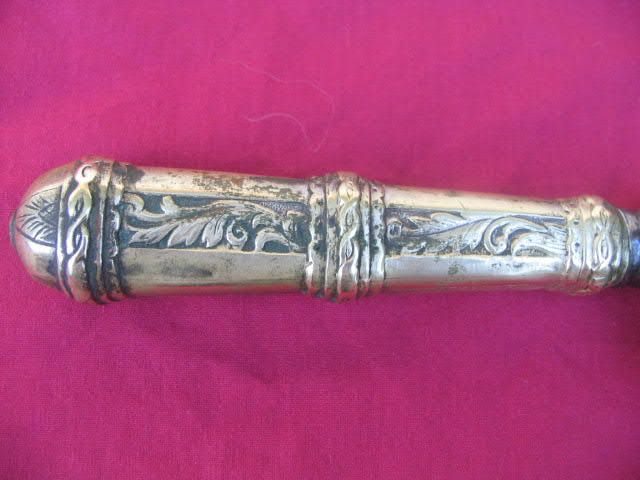
|
|
|

|
|
|
#4 |
|
Member
Join Date: Jun 2008
Posts: 119
|
very nice indeed.

|
|
|

|
|
|
#5 |
|
Member
Join Date: May 2006
Posts: 7,135
|
Although I'm primarily a keris person, I also have a pretty large accumulation of gaucho knives. Know almost nothing about them.
|
|
|

|
|
|
#6 |
|
Member
Join Date: Apr 2007
Location: Nothern Mexico
Posts: 458
|
A. G. Maisey, I feel that there are different worlds in the matter of edged weapons comming from the spanish speaking countries, and the weapons comming form other countries. The formers being less known and collected. I never understood why, since they have a very rich diversity, and La Fábrica de Armas Blancas de Toledo or other places where edged weapons were produced, there was a great tradition in weapons of the highest quality in the world, even imitated by Solingen. There are still some places where that tradition survives, like Argentina. They even have a forum dedicated mainly to the making of these and other styles of edged weapons, maybe the best in the spanish speaking world:
http://www.armasblancas.com.ar/foros/ In spanish we use the concept of "armas blancas" (whithe weapons), meaning edged weapons made from iron or steel, but not from other materials. We don´t have the general concept of "edged weapons", in which stone or bronze weapons could enter. We can speak about knives used mainly by the gauchos, but those were not used only by them, but by all the argentineans and uruguayans, mainly from the countryside. The gaucho was a poor cowboy which usually couldn´t afford knives mounted completely in silver. Those were knives used by the middle and hight classes. They are still made in the form you see in the above picture, mounted in silver or in leather. This kind of knife specifically, is called "puñal criollo". The smaller ones are called "verijero", as they were carried not in the back, but in the front, near of the private parts or "verijas". The puñal criollo come from the mediterranean knife, with elements from the canarian knife. Maybe the most local and gaucho knife is the "facón", a very big "knife" from 35 to 80cm long, the longer ones called "facón caronero", as they were carried under the caronas, a part of of the harness of the horse, which resembles more a moor horse seat, different from the horse leather and wood chairs used by other peoples. Other edged weapons used by the gauchos were the daga (dagger) and the cuchilla. They were usually weapons without too much fancies, unless used by upper classes. There are some good books about this wepons in spanish, written by Abel Domenech, an erudite and collector from Argentina. I can recommend two of his books on the subject: "Dagas de Plata" (Daggers of Silver) and "Del Facón al Bowie" (From the Facón to the Bowie"), but the first is more specific on the subject. I can even invite him to participate in this forum, if the administrators and moderators belive it convenient to the discussion over this subject. Maybe he is the best specialist in this kind of "knives" (if you can call "knife" to a 80cm edged weapon), in the whole world, yet he is a very unpretentious and nice man. Not very common. My best regards Gonzalo PS: Rick, I pulsed the link, but it gives "No Matches". |
|
|

|
|
|
#7 | |
|
Member
Join Date: Mar 2005
Location: Australia
Posts: 685
|
Quote:
http://www.vikingsword.com/ethsword/facon/index.html Cheers Chris |
|
|
|

|
|
|
#8 |
|
Arms Historian
Join Date: Dec 2004
Location: Route 66
Posts: 10,745
|
This is an excellent topic, and blends well with that of Spanish Colonial edged weapons.
Gonzalo, thank you so much for the well thought out and beautifully written post describing these facinating knives and the colorful history of the Gauchos of Argentina. It is great when individuals here who have deep interest and knowledge on a specific weapon or field of study take the time to write in text, and share that knowledge. I am also glad to see Chris Evans posting here on this, as his resounding knowledge and research on these has for some time stood as a key source for information on these weapons. In using the search feature here, under 'gaucho knife' these posts will reveal most comprehensive material and discussion on these knives. The example posted by NagaWarrior is indeed very attractive and it should be noted, has at the back of the blade the mysterious 'Spanish notch' which reveals the intriguing ancestry of these knives. Last edited by Jim McDougall; 14th July 2008 at 12:02 AM. |
|
|

|
|
|
#9 |
|
Member
Join Date: Dec 2004
Location: Kernersville, NC, USA
Posts: 793
|
I love them, and have a few from the late 20th century. Don't know much about them though, and would like to know more. I think the blade shape is very useful and pleasing to the eye.
Steve 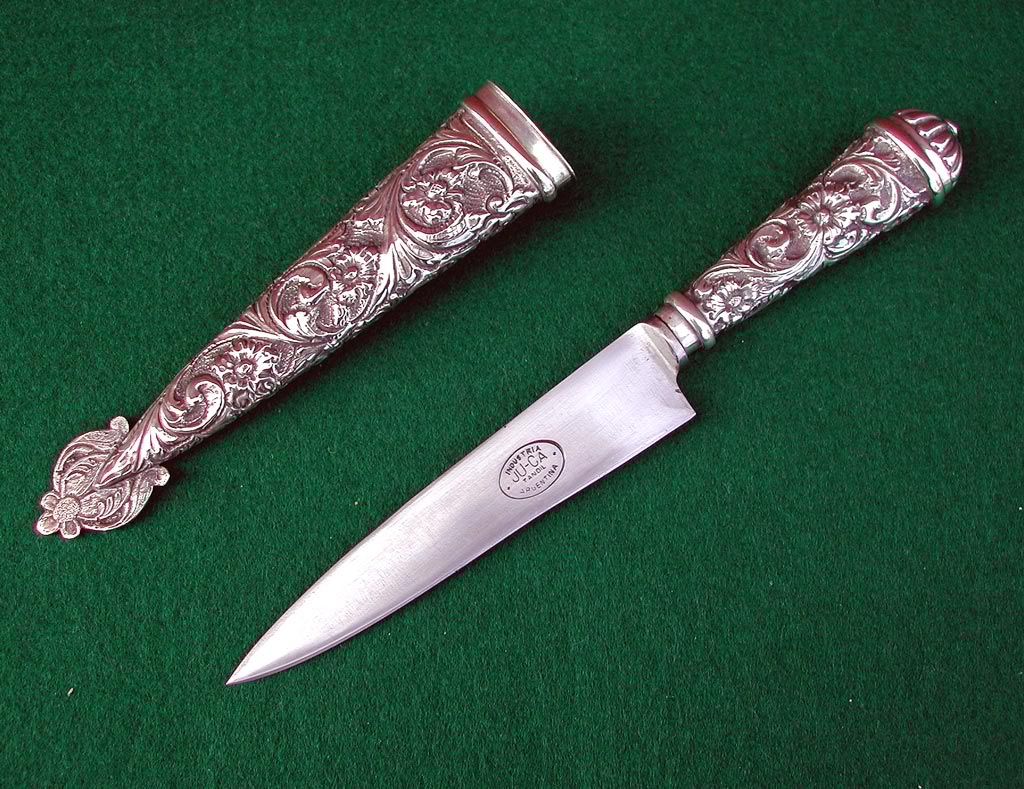
|
|
|

|
|
|
#10 |
|
Member
Join Date: May 2006
Posts: 7,135
|
Not all strictly "gauchos", as we think of them, but all of a type.
A few of mine. |
|
|

|
|
|
#11 |
|
Member
Join Date: Mar 2005
Location: Australia
Posts: 685
|
Hi,
Jim: I feel flattered by you generous remarks and will here try to add a little to the excellent post by Gonzalo and very informative article by Jones. Discussing `gaucho'knives is a bit like discussing cowboy revolvers - The Colt SA 45 is the one most associated with the Wild West, but there were any number of others in circulation, and rarely used as depicted by Zane Gray or in the movies. The gaucho knife that nowadays we recognize as such very much emerged in the course of the 19th century and the lore associated with it with, is enextricably bound with the stories of Martin Fierro by Hernandez http://en.wikipedia.org/wiki/Martin_Fierroand and Juan Moreira by Gutierrez http://en.wikipedia.org/wiki/Juan_Moreira. These two characters, one entirely fictional and the other depicted much larger than in life, epitomized an idealized stereotype of life on the land that the population of an emerging nation could identify with. I hold with those who believe that the true era of the `gaucho' was before 19th century, by which time, save the outlaws in the furthest frontier regions, he was reduced to a mere `peon', an agricultural labourer, often gang-pressed into the provincial wars and afterwards disarmed - Various edicts having denied him the freedom to roam. The knife for the gaucho was primarily a tool, which could be turned to violent usage if required, but a tool nevertheless - The often made assertion that it was it was his weapon of choice over all others is sheer nonsense promulgated my literary myth makers. In real life, sabres and firearms were very much coveted, but hard to get. A humorous depiction of this fall from grace was given by George Mikes which goes something like this: The downfall of the gaucho was the fork - He was a free man as long as he was content to eat solely with his knife - But a fork requires a plate, a plate a table, a table a chair, and all this a roof and a steady job! BTW. As Gonzalo reminds us, the ornate silver mounted knives that nowadays we associate with the genre were very much confined to the wealthy landowners, their overseers and the well to do.But the common man on the land had to content himself with whatever he could lay his hand on. With the introduction of `German silver' (Spanish:Alpaca) this style of mounting affordable knives became the norm only in the 20th century. Until WWII, blades were imported from Europe, everything from discarded swords, bayonets and trade butchers blades, mostly German and French, which were hilted and given sheaths by local craftsmen. Blade lengths varied from the diminutive 4" `Verijero' to the sword length `Facon Caronero' mentioned by Gonzalo. Bernard Levine tells us, that as WWII interrupted the importation of trade blades, in 1943 local manufacture of the same commenced in the in the province of Buenos Aires at Tandil. The term most often associated with gaucho cutlery is the long bladed `facon', invariably made from a discarded sword or bayonet. Its primary purpose was probably that of a slaughtering tool, but it is also the most often variant mentioned in fights. In his regard, it is worth mentioning that by the middle of the 19th century the wearing of facons was severely discouraged by landowners, or even outright prohibited, as exemplified by the rules set down by the rancher and later president Rosas http://en.wikipedia.org/wiki/Juan_Manuel_Rosas. Nowadays the facon is completely obsolete, except as a collector's item. The facon made from sword and bayonet blades made for a poor knife because its temper and cross sectional geometry was less than ideal. As such, the predominant form in day to day usage was what we would call a stiff butcher's knife, somewhere between 6" and 12" in blade length. Gaucho knives were known by several names, and these were until fairly recently used loosely. Domenech has attempted to make a stricter and more meaningful classification, distinguishing between the various forms by attributes such as blade length, general shape, number of edges and hand-guard. In closing, I refer interested readers to Osrnio's Esgrima Criolla (Creole Fencing) and Abel Domenech's Dagas De Plata. Cheers Chris |
|
|

|
|
|
#12 |
|
Member
Join Date: Mar 2005
Location: Australia
Posts: 685
|
Nagawarrior and Maisey,
You two have some intersting old pieces. Any chance of giving us the brand on the blades? Ferguson: You have a handsome modern piece. Is the hilt and sheath silver or german silver? Cheers Chris |
|
|

|
|
|
#13 |
|
Member
Join Date: Mar 2006
Location: Room 101, Glos. UK
Posts: 4,268
|
here's my modest set: all 'new'
top is a modern 'gaucho' fighting knife from mission in argentina i picked up a few years ago. 10 in. carbon steel blade & guard, full tang. scales are wood, riveted on. i wrapped and varnished the grip to fit my hand a bit better. the notch is usefull if you choke up on the grip. middle is a smaller criollo from tandil, from last year or so. wood grip, alpaca fittings (german silver), 5.25 in. carbon Steel blade. nice 'S' at the blade/grip junction on the blade. i like the leather sheaths with their central seam, belt flap and shirt protector fan at the top. bottom is a more decorative one with an etched 7 in. 'inox' (stainless) blade, marked with a trumpet as a makers mark. un-hallmarked silver (plated?) grip & scabbard, turning a nice black patina i'd expect from a silver alloy. 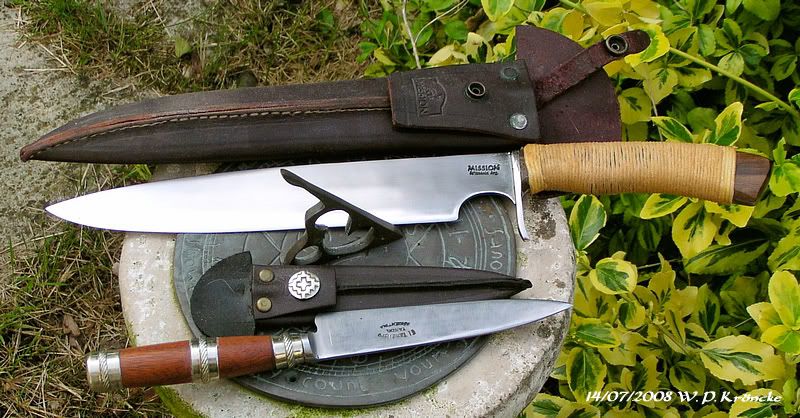 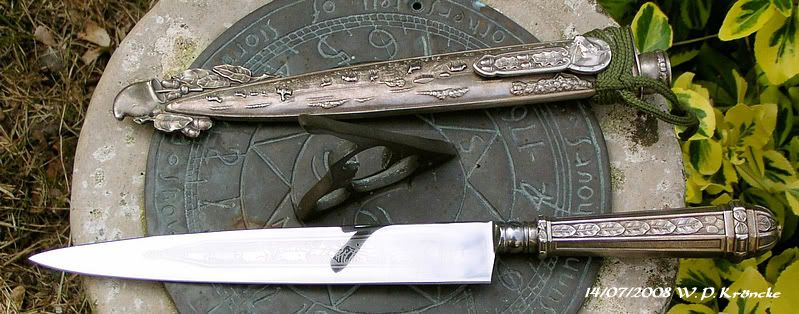
Last edited by kronckew; 14th July 2008 at 10:07 AM. |
|
|

|
|
|
#14 |
|
Member
Join Date: May 2006
Posts: 7,135
|
Yeah Chris, no problemo.
From the top---modern in leather sheath 1---no name, Brazil, about 20 years ago, by supposedly last traditional smith in the country 2---A. Panizzi y C??., Artes 122 B-Aires 3--- no blade stamp 4--- (second pic, black hilt) Verminck & Desteves, Montevideo 5--- A. Panizza y Cia, Artes 122 B-Aires 6--- S Holberg, Joucla Y Silva ???? 7--- JJ CA, Tandil, Argentina 8--(vertical, LHS) J,Jnvernizzi, Buenos Aires 9--- (two vertical RHS)--Brazil, no blade marks, very old. 10--- (bottom , pierced ricasso) an ancestor:- meditteranean dirk, 17th-18th century |
|
|

|
|
|
#15 | |
|
Member
Join Date: Mar 2005
Location: Australia
Posts: 685
|
Quote:
Cheers Chris |
|
|
|

|
|
|
#16 |
|
Member
Join Date: Jun 2008
Posts: 119
|
the first knife in AJ's post looks alot like this bosnian dagger i was barely outbid on on ebay:
http://cgi.ebay.com/ws/eBayISAPI.dll...m=230264213939 |
|
|

|
|
|
#17 | |
|
Member
Join Date: Apr 2007
Location: Nothern Mexico
Posts: 458
|
Quote:
Yes, it´s a nice work. The blade is commonly known as a "Tandil", and the chasing work belongs to the School of Olavarria, an old school which is characterized by the baroque style of decoration, very profuse and rich. It´s counterpart, is the School Rioplatense, which is characterized by a decoration more sober, like the one you can find in the cuchillos criollos exposed here in the other pictures. It is ver common for the silversmtihs to purchase an already made blade, and to mount it with their work. Is the same with the "sogueros", the people who works leather to make hilts over wood, and sheaths for the criollo knives. You can see a beatiful work of soguería in this tutorial here: http://www.armasblancas.com.ar/foros...t=6047&page=10 I expect you can see it without registering. If not, I can get a permission to post the picture in this forum. My regards Gonzalo My regards Gonzalo |
|
|
|

|
|
|
#18 |
|
Member
Join Date: Apr 2007
Location: Nothern Mexico
Posts: 458
|
Chris, a very precise description. The gaucho was a frontierman, a nomad usually living and sleeping in the open, hunting wild cattle and trading with the indians, form whom he learnt many things, as the use of the boleadoras to chase cows and cimarron horses. Like a mountainman in the USA, but in another geography, la pampa, the great plains with pastures, just like the big plains in Dakota, USA. He was also a bootlegger form Argentina to Chile, a bandit, an occasional cowboy for the landowners and a cavalry soldier in the civil wars and the wars against the colonial powers. However, I want to make some precisions. The real gaucho endured maybe to the middle of the 19th Century, as a nomad and occasional cowbow, bandit and bootlegger. Blades made industrially were imported from Europe, but there was also a local blacksmithing production which made several blades for the market, mainly from used files. Facones were not always made from broken swords or sabers (there are also antique curved facones made in this way), and discarded bayonets, but also with blades made by local blacksmiths, sometimes with fullers, sometimes without them. The gaucho was ultimately finished by the private appropriation of the land, the wire fences surrounding the land and their prosecuting by the government authorities. The gaucho usually carried more than one knife. He carried usually a small criollo or verijero and a facon, or a puñal criollo and a facon. I read the article about the facon here, The part of the buttons must be reworked. Argentineans also uses rounded buttons, but are different from the uruguayans. The description of the buttons can be made with precision to identify their origin without doubts, and there is another type of button, not mentioned, the riograndense button, from the region of Rio Grande (Great River). Faca in portuguese just means "knife", and facon means big knife. As reference, the books are:
Abel Domenech Dagas de Plata privately edited by the author Buenos Aires, Argentina, 2005 Mario López Osornio Esgrima Criolla Ediciones Nuevo Siglo (Biblioteca de la Cultura Argentina No. 9), Buenos Aires, Argentina, 1995 The last, is in fact a smal manual about knife, rebenque (the leather tool used to incentivate the horse, I don´t remember the name in english in this moment), poncho and chuza (a spear) combat techniques. A very small manual in fact, and difficult to get. But Abel has his own page and you can purchase his books from there: http://www.domenech.com.ar/ He´s also one of the moderators of the Forum Armas Blancas. My regards Gonzalo Last edited by Gonzalo G; 15th July 2008 at 06:13 AM. |
|
|

|
|
|
#19 |
|
Member
Join Date: Apr 2007
Location: Nothern Mexico
Posts: 458
|
A. G. Maisey you have some brazilians facas over there, and mostly puñales criollos. The puñal usually have a drop point with a false edge, and a button where the blade ends, at the beginning of the hilt. No guards. There is silverwork from the Olavarriense school, and the Rioplantense School. The facas look like made from bayonets, but I´m not sure. The last puñal criollo on the photo, below, has a piece of silver or alpaca covering the ricasso of the blade. This piece is called "empatilladura", and it has similar functions as in the yataghans: it is an ornament, but also a pice which gives more rigidity to the blade and absorbs part of the vibrations when you chop with the kife or parry another knife. It also serves to avoid rubbing the blade against the metal entrance of the sheat and secures the knife in there.
The blade from Adolfo Panizza & Cia is from the end of the 19th C to the beginning of the 20th C. Panizza was an importer. The sixth is Scholberg, Joucla & Silva, a variant of the Broqua & Scholberg, a Liege, Belgium, blademaker. Probably the knife is from the fist quart of the 20th C The seventh is a Juca, Tandil, an argentinean blademaker from the mid of the 20th C, still working today. The others I can´t remember right now, I must search in Abel´s books. My regards Gonzalo |
|
|

|
|
|
#20 |
|
Member
Join Date: Apr 2007
Location: Nothern Mexico
Posts: 458
|
Kronckew, your first is a free interpretation of the criollo, not really a criollo, but a modern style knife inspired on. The puñal criollo has no guard, but it has always a button. This kife was mounted by poor children in a kind of special institution in Argentina (Misiones). The second is a verijero and the third a puñal, those last made in the real tradition of the puñales criollos.
My regards Gonzalo |
|
|

|
|
|
#21 |
|
Member
Join Date: May 2006
Posts: 7,135
|
Thanks for your comments, Gonzalo.
The two RHS vertical knives could be from bayonets, but if they are, they have been extensively reworked, as both have a strong distal taper and some spring in the blade. The bottom knife that looks as if it has silver over the ricasso is in fact a early European knife, not a South American knife. What looks like ornamental silver is in fact an ornamented steel ricasso, an integral part of the blade |
|
|

|
|
|
#22 | ||
|
Member
Join Date: Mar 2005
Location: Australia
Posts: 685
|
Hi Gonzalo,
Great post - Your differentiation between the Olavarriense school, and the Rioplantense school is raising this thread to the next level! Quote:
"The button can take a semi round form, known by collectors as round, little ball or oriental, and which define the blades used in Uruguay, Rio Grande do Sul (Brazil) and the mesopotamic zone of our country (CE: North East Argentina)... The "porteño" (CE: From Buenos Aires city) button is known as quadrangualr, though in reality it is more or less octagonal......although there is no definitive explanation that accounts for the different shapes adapted in the various regions" Could you please throw a bit more light on the subject of buttons? Quote:
Cheers Chris |
||
|
|

|
|
|
#23 |
|
Member
Join Date: Apr 2007
Location: Nothern Mexico
Posts: 458
|
First of all, I must excuse myself for my writting errors. In other post I worotte "whithe" instead of "white" and so on. The name of the schools are School of Olavarria and School of Rio de la Plata. You can refer to them as the olavarriense and rioplatense schools "ense" meaning "belonging to". As you know, Olavarria and Rio de la Plata are two places on Argentina. Those are "modern" schools, from the 19th Century, and are only related to the schools mentioned by Abel in some way. As I understand, and I´m not argentinean or a truly expert on this weapons, you can relate the rioplatense school to the old Pampa school mentioned by Abel, but only in relation with the sobriety of motifs, not in relation with their origin in the araucano or pampa motifs, which are indian. The schools mentioned by Abel are the old schools, but when coming to classify the above cuchillos criollos, which are modern, the old schools classification does not apply in the same form, as the motifs have been mixed in modern times. Anyway, the olavarriense school uses predominantly renaissance style motivs.
I meant the buttons paragraph needed reworking in the sense it needs more explanation. Your translation is correct, but it only touches very lightly the subject. For example, the uruguayan button is a round ball, but it has two symmetrical rounded rings in it´s sides at the same height of the ball, so it is really a rounded ball and not an octagonal piece. Some argentinean buttons are round, but with one ring, or with two rings but not symmetrical or rounded, with a flat spine. The specific uruguayan culture have been differenciating in more measure from the last half of the 19th C from the argentinean. Maybe the specific uruguayan button comes from this period, maybe not. It is a subject I must research. The riograndese button has the rings and the "ball" in an octagonal form, but it can be also just a rounded ring (not a ball) between two flat (flat on their spines) rings, more narrow. Sometimes the main ring can be rounded on the spine, but oblong in the general form. There are many variations you must deal with, and so the classification must be detailed in a further direction. It would need somo more extense decription and illustration. This classification of the rings which I mention is related to the most modern puñales criollos, as I said, from the 19th C, and you must take on account that it is a live tradition in which the work on the buttons and silver motifs mixes elements and add new ones. If you see the book from Abel, you will find those variations. |
|
|

|
|
|
#24 | |
|
Member
Join Date: Mar 2005
Location: Australia
Posts: 685
|
Hi Gonzalo,
And yet another excellent post on the subject . Thanks from all of us here - We greatly appreciate your contribution. Apart from Domenech, is there anybody else seriously researching these knives? I regularly read the posting on armasblancas.com, but so far, the best postings always come from Domenech. As an aside, did you read the one on San Martin's sabre? Quote:
Cheers Chris |
|
|
|

|
|
|
#25 |
|
Member
Join Date: Apr 2007
Location: Nothern Mexico
Posts: 458
|
I wrotte in the San Martín sabre thread. I´m Yataghan there. I only saw the thinny picture of the sabre, but a week latter, in other place, I saw a reproduction. It was made as a mameluke shamshir. The point of the hilt is VERY different from the one you can see on the unclear picture posted in the thread. Without good pictures, an authentic story and a metallurgical analysis made public, one can only make very wide (and wild) speculations.
It is not difficult to know the details of the buttons, if you speak spanish. Marcial, on that forum, knows very well the buttons, and also, you can communicate with Abel throught the forum. If you open a thread, I´m sure you will find several people who can add rich contributions. Some plateros (silversmiths) knows very well the schools and the type of buttons. There is a subfora there dedicated to the silversmithing. They make sheats and hilts just like the ones you see here, in this thread, and some of the silversmiths also have a good knowledge of the button styles. Marcial is a bladesmith, not a researcher, but he has made some research and knows very well the old and new criollo blades. I can give you my modest support to help you with your thread over there. Abel is semiretired from the forum because he´s in the last stages of the publication of his last book, about folder knives, but we can send him an invitation to participate. I don´t know any other serious research about this subject. In fact, I think I´m going to send him a message with a link to this thread. My regards Gonzalo |
|
|

|
|
|
#26 |
|
Arms Historian
Join Date: Dec 2004
Location: Route 66
Posts: 10,745
|
When Chevalier first presented the query that is the topic of this thread, the knives of the Gauchos, the esoterica of the subject itself was intriguing. I was immediately drawn to try to find any material I could so I could respond. I began poring through resources and what notes I had available as usual to try to compose as responsible a response as possible, but found that trying to quickly put together a brief synopsis on these was much more formidable than I realized!
I noticed in checking through searches of previous discussions that Chris Evans clearly knows these weapons, and presented numerous outstandlingly detailed posts. Then Gonzalo's post revealed he too had excellent knowledge on these knives.The following posts by Mr.Maisey, Kronckew, Nagawarrior and Ferguson added beautiful examples to add to the great information and discussion that Chris and Gonzalo continue to develop. I just wanted to say that this thread is 'textbook'!!!! That is exactly the kind of discussion and interaction I always look for here. A prefectly gentlemanly discourse with detailed and sound information presenting comprehensive material focused on a weapon form that will stand as a usable resource for collectors and future research. It is fantastic because here not only is published material available on the topic noted, but the results of active research, field study and the experience of active collectors bring the entire topic 'up to speed'. Gentlemen, please keep this thread going, its terrific to see this topic developing from an intriguing knife seldom discussed to that of an ethnographic utilitarian weapon that distinctly represents a colorful and fascinating history much more complex than I had ever realized. Fantastic!  Thank you very much!!! All best regards, Jim |
|
|

|
|
|
#27 |
|
Member
Join Date: Apr 2007
Location: Nothern Mexico
Posts: 458
|
On the contrary, thank you, Jim, for your words. I don´t dreserve them. Serious. I´m not what can be called a "specialist" in this subject. Abel is. And also a great collector of this kind of knives. The point of the schools, as you can expect, is a subject of discussions, but this is a normal part when comming to classify.
My best regards Gonzalo |
|
|

|
|
|
#28 |
|
Member
Join Date: Mar 2005
Location: Australia
Posts: 685
|
Jim,
Thank you for your generous praise of my modest contributions, but in truth, most of what I know of these knives comes from those two books and having seen their usage first hand during my travels in Sth America. In truth, it is very difficult to say much that is new on these knives with any certainty because what can be said has already been stated by Domenech and to a lesser extent Osornio, both sadly untranslated, and the rest is lost in the mists of time and intertwined with myths. These knifves have gained a symbolic role in modern times, as have the Spanish navajas, both as national icons and reminder of a colorful past. As such, despite being obsolete, both have found a new lease of life. There are now superb artisans (see link), turning out pieces of previously undreamed of quality and ornateness. These masterpieces are rarely used, though it is common for well to do men to attend barbecues (Argentine Spanish: Asado) dressed in traditional garb, with a diminutive but very ornate knife tucked into their belt, but this is about as far as it goes. And so, much of the arcane minutiae associated with these knives pertains to this modern breed. For example, according to Domenech, the Olavarria school of silver work for knives reached its full development in the 1925-40 period, an era by which the only gauchos to be found were in the theatres, not that any real gaucho could ever afford one. From all of this, it can be seen that the indiscriminate association of these knives with gauchos is, to my mind at least, inappropriate, and a much better umbrella term is `Creole Knife' (Spanish: Cuchillo Criollo). http://www.pallarols.com.ar/ Best seen in Spanish Cheers Chris Last edited by Chris Evans; 17th July 2008 at 01:47 PM. |
|
|

|
|
|
#29 | |||
|
Member
Join Date: Mar 2005
Location: Australia
Posts: 685
|
Hi Gonzalo,
Quote:
Quote:
Quote:
Cheers Chris |
|||
|
|

|
|
|
#30 |
|
Member
Join Date: Apr 2007
Location: Nothern Mexico
Posts: 458
|
Chris, thank you for your kind words. I agree with your statements about criollo knives. Tough it seems that the puñal criollo and the verijero, unornated, is still actually used by the country laboureers as a daily tool, but not the facones and dagas. Although I can´t be personally certain of this, those are references given by argentineans.
I asked Abel for an article for this forum about this subject, and he generously accepted my petition. I will be honored to be the conduct to upload it on the forum, as Abel is troubled now with his new book. It has to be noted, also, that the situation in Argentina is very difficult right now, with social and political conflict reaching a new peak. There are clouds of serious violence over there, and many are afraid of a civil conflict of great proportions. My regards Gonzalo |
|
|

|
 |
|
|